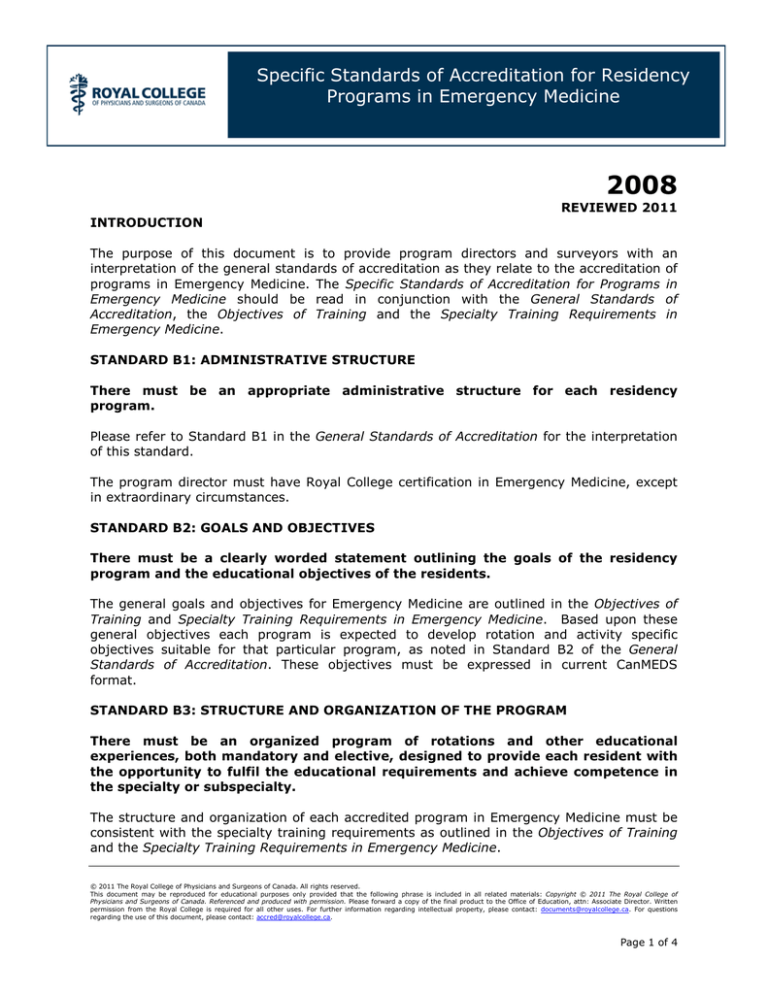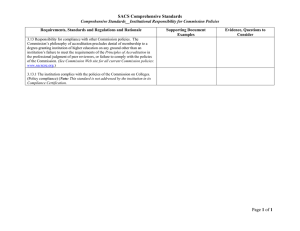
Specific Standards of Accreditation for Residency
Programs in Emergency Medicine
2008
INTRODUCTION
REVIEWED 2011
The purpose of this document is to provide program directors and surveyors with an
interpretation of the general standards of accreditation as they relate to the accreditation of
programs in Emergency Medicine. The Specific Standards of Accreditation for Programs in
Emergency Medicine should be read in conjunction with the General Standards of
Accreditation, the Objectives of Training and the Specialty Training Requirements in
Emergency Medicine.
STANDARD B1: ADMINISTRATIVE STRUCTURE
There must be an appropriate administrative structure for each residency
program.
Please refer to Standard B1 in the General Standards of Accreditation for the interpretation
of this standard.
The program director must have Royal College certification in Emergency Medicine, except
in extraordinary circumstances.
STANDARD B2: GOALS AND OBJECTIVES
There must be a clearly worded statement outlining the goals of the residency
program and the educational objectives of the residents.
The general goals and objectives for Emergency Medicine are outlined in the Objectives of
Training and Specialty Training Requirements in Emergency Medicine. Based upon these
general objectives each program is expected to develop rotation and activity specific
objectives suitable for that particular program, as noted in Standard B2 of the General
Standards of Accreditation. These objectives must be expressed in current CanMEDS
format.
STANDARD B3: STRUCTURE AND ORGANIZATION OF THE PROGRAM
There must be an organized program of rotations and other educational
experiences, both mandatory and elective, designed to provide each resident with
the opportunity to fulfil the educational requirements and achieve competence in
the specialty or subspecialty.
The structure and organization of each accredited program in Emergency Medicine must be
consistent with the specialty training requirements as outlined in the Objectives of Training
and the Specialty Training Requirements in Emergency Medicine.
© 2011 The Royal College of Physicians and Surgeons of Canada. All rights reserved.
This document may be reproduced for educational purposes only provided that the following phrase is included in all related materials: Copyright © 2011 The Royal College of
Physicians and Surgeons of Canada. Referenced and produced with permission. Please forward a copy of the final product to the Office of Education, attn: Associate Director. Written
permission from the Royal College is required for all other uses. For further information regarding intellectual property, please contact: documents@royalcollege.ca. For questions
regarding the use of this document, please contact: accred@royalcollege.ca.
Page 1 of 4
The program must structure the sequence of activities so that the experience acquired will
permit the resident to assume the graded responsibility that is appropriate to the level of
training, throughout the five years. Expectations concerning responsibility must be specified
for each level. The senior resident must be regularly entrusted with the overall responsibility
for 1) the diagnosis, resuscitation, stabilization, evaluation and disposition of acutely ill and
injured patients of all kinds; 2) the clinical management of the Emergency Department and
of overall patient flow.
The program should be designed to make optimal use of its resources to ensure the desired
educational experience. Activities which are not organized on the traditional one-month
block or horizontal rotation basis must be clearly identified, tracked and compiled so that it
is possible to easily assess whether the program conforms to the prescribed activity-block
time requirements in months.
STANDARD B4: RESOURCES
There must be sufficient resources including teaching faculty, the number and
variety of patients, physical and technical resources, as well as the supporting
facilities and services necessary to provide the opportunity for all residents in the
program to achieve the educational objectives and receive full training as defined
by the Royal College specialty training requirements.
In those cases where a university has sufficient resources to provide most of the training in
Emergency Medicine but lacks one or more essential elements, the program may still be
accredited provided that formal arrangements have been made to send residents to another
accredited residency program for periods of appropriate prescribed training.
Learning environments must include experiences that facilitate the acquisition of knowledge,
skills, and attitudes relating to aspects of age, gender, culture, and ethnicity appropriate to
Emergency Medicine.
Through the facilities of the university and the participating institutions, the overall
residency program must satisfy the following requirements:
1. Teaching Faculty
Each institution must have a sufficient number of qualified staff to provide continuous
supervision and adequate clinical instruction for the residents in Emergency Medicine. The
teaching staff should have a nucleus of members with a level of experience and qualification
sufficient to ensure the overall quality of the teaching activities.
2. Number and Variety of Patients
The volume and variety of patients in the institutions participating in the program, taken
collectively, must be sufficient to provide residents with opportunities for training and
experience over the full spectrum of the clinical conditions associated with an active
Emergency Department, including adult and childhood illnesses, injuries, and conditions. A
combination of institutions may be used to offer the full spectrum of required experiences.
© 2011 The Royal College of Physicians and Surgeons of Canada. All rights reserved.
Page 2 of 4
3. Clinical Services Specific to Emergency Medicine
A participating Emergency Medicine Department must be under the direction of an
emergency physician and must be adequately resourced to allow the department to fulfil its
academic mission as a core training site. Each Emergency Department that participates in
the program must have an adequate number of patients available for teaching, and must be
administered by a director or head of the department with adequate links to the university
academic administrative unit for Emergency Medicine. Departments with a major role in the
Emergency Medicine program should be engaged in the teaching of Emergency Medicine at
multiple levels, according to regional demand and assuming that appropriate resources are
available to support these teaching activities.
There must be access to medical services for pre-hospital care, such as paramedics,
ambulance services, communication systems, first aid programs, poison control, public
education, organization of emergency medical services and disaster planning, so as to
provide experience in the administrative and supervisory aspects of emergency medical
services.
There must be adequate space for administration, teaching and research. This should
include a conference room, dedicated non-clinical workspace for residents in Emergency
Medicine, and on-site access to relevant reference materials specific to Emergency Medicine.
4. Supporting Services - Clinical, Diagnostic, Technical
There must be access to all the services specified in the Objectives of Training and Specialty
Training Requirements in Emergency Medicine. These should include diagnostic resources,
namely biochemistry, hematology, microbiology and diagnostic imaging. Appropriate
bedside diagnostic resources must also be available.
Consultative services must be readily available from all the major specialties and
subspecialties. There must be appropriate liaison with teaching services in other relevant
medical and surgical specialties and subspecialties
STANDARD B5:
CLINICAL,
PROGRAM
ACADEMIC
AND
SCHOLARLY
CONTENT
OF
THE
The clinical, academic and scholarly content of the program must be appropriate
for university postgraduate education and adequately prepare residents to fulfill
all of the CanMEDS Roles of the specialist. The quality of scholarship in the
program will, in part, be demonstrated by a spirit of enquiry during clinical
discussions, at the bedside, in clinics or in the community, and in seminars,
rounds, and conferences. Scholarship implies an in-depth understanding of basic
mechanisms of normal and abnormal states and the application of current
knowledge to practice.
Please refer to Standard B5 of the General Standards of Accreditation, the Objectives of
Training, the Specialty Training Requirements in Emergency Medicine, and the CanMEDS
Framework for the interpretation of this standard. Each program is expected to develop a
curriculum for each of the CanMEDS roles, which reflects the uniqueness of the program and
its particular environment. Specific additional requirements are listed below.
© 2011 The Royal College of Physicians and Surgeons of Canada. All rights reserved.
Page 3 of 4
1. Medical Expert
The General Standards of Accreditation apply to this section.
2. Communicator
The General Standards of Accreditation apply to this section.
3. Collaborator
The General Standards of Accreditation apply to this section.
4. Manager
The General Standards of Accreditation apply to this section.
5. Health Advocate
The General Standards of Accreditation apply to this section.
6. Scholar
The General Standards of Accreditation apply to this section.
7. Professional
The General Standards of Accreditation apply to this section.
STANDARD B6: EVALUATION OF RESIDENT PERFORMANCE
There must be mechanisms in place to ensure the systematic collection and
interpretation of evaluation data on each resident enrolled in the program.
Please refer to Standard B6 in the General Standards of Accreditation for the interpretation
of this standard.
99 03 26 - Approved by Executive Committee
Revised – Education Committee – November 2004
Revised – SSRC – June 2008
© 2011 The Royal College of Physicians and Surgeons of Canada. All rights reserved.
Page 4 of 4

